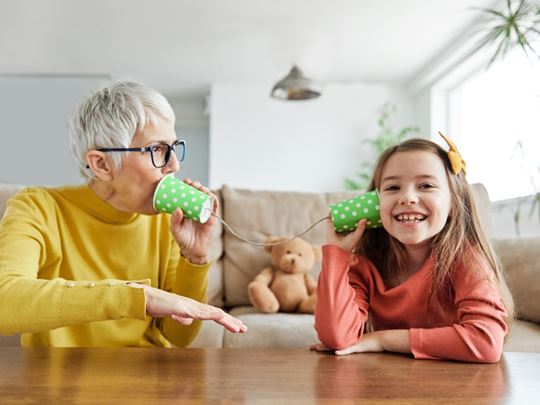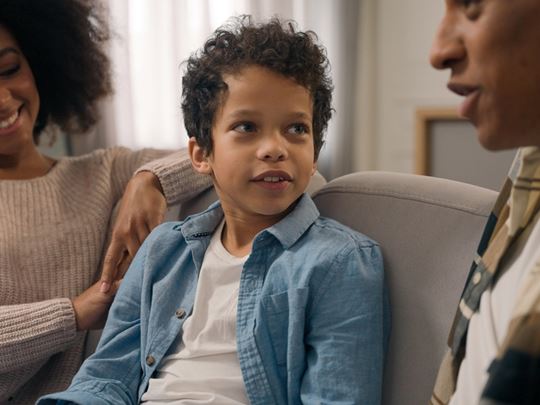Why is communication important in child development?
Children learn how to communicate with others through their early relationships. These relationships support their understanding of the world and how they fit into it. They teach children how to interact with others and whether it is safe or not to share their thoughts and emotions.
When children are young, they communicate through their cries, letting their caregiver know they are hungry, tired or need comfort. How their caregiver responds impacts the way they’ll communicate in the future. If their caregiver is attentive, comforting and consistent, children know that when they express their thoughts and feelings, they’ll be listened to and comforted.
If a child’s caregiver doesn’t respond to their cries, is inconsistent or punishes them for expressing their needs, they may learn that the only way to communicate effectively with others is by adjusting how they convey their thoughts and feelings.
Children who’ve had no choice but to change how they communicate will likely continue to express themselves in this way when they move in with a fostering family. But, with your love, support and consistency, we can help foster children feel able to share their emotions and learn new, healthier ways to communicate with you and their peers so they can build healthy relationships.

Identify barriers to effective communication
For children in care, there can be numerous barriers to effective communication. They may have had to adapt their communication style, and many foster children have complex trauma due to their adverse childhood experiences. Barriers could include:
- Trust – children in care may struggle to trust because their experiences have taught them that their thoughts, feelings and emotions aren’t safe in the hands of others.
- Emotions – children in care may have had no choice but to adapt how they share their emotions. It means they may hide them or express them more intensely. Trauma can also make it difficult for children to regulate their emotions because our caregivers teach us how to do so, and trauma can interrupt this area of development. Therefore, they may struggle to communicate their feelings with words, expressing them through their behaviour instead.
- Hypervigilance – when a child experiences prolonged abuse or neglect, their brain adapts so they can quickly assess their environment for danger. It means they can become easily over-stimulated by their surroundings and struggle to pay attention as their heightened senses absorb sensory information.
- Dissociation – when a child experiences something traumatic that they can’t escape from or cope with emotionally, they may mentally leave the situation; this is called dissociation. When they are no longer in danger, they may continue dissociating, which could mean they zone out of conversations and forget what is said.
- Cognitive Functioning – trauma can delay a child’s language development and impact their ability to learn and problem-solve. It could mean they may have difficulties understanding or following conversations.
How to help a child with communication difficulties
Although there may be multiple barriers to effective communication with your foster child, by adapting your approach to communication, you can overcome them together.

Building trust
Building trust starts by providing your foster child with a loving home and consistently meeting their needs. Implementing a routine can go a long way in building trust because your foster child will know what to expect and feel more secure. You can also build trust by spending quality time with them and valuing their input. For example, you could ask them to choose a recipe for dinner before cooking it together.
Building trust is additionally about listening to what your foster child has to say, whether verbally or non-verbally, through their body language, behaviour and tone of voice. At FCA Scotland, our foster care training will enable you to build trust with your foster child and decode their behaviour, so you understand what they are trying to convey.
Supporting emotional regulation
Supporting the emotional needs of your foster child will help you communicate with each other more effectively. It means taking the time to work through their emotions whilst offering non-judgemental support, so they feel safe enough to share how they think and feel.
You can use picture books and worksheets to help them name their feelings and share your calm with them in moments of heightened emotions through gentle touch and a softened tone. Your foster child needs to know their feelings are valid and you accept them for who they are.
By consistently helping your foster child through their emotions and modelling emotional regulation, you can teach them how to communicate their feelings in a healthier way.
Preventing overstimulation
When communicating with a hypervigilant child, it’s vital to be aware of your surroundings. Ensure you are in a quiet and familiar environment, away from distractions or anything that could overstimulate your foster child. They may prefer to be seated by an exit so they know they can escape the situation if it gets too much, and if they start to panic, you can help them by encouraging them to use mindfulness strategies, such as deep breathing.
Helping foster children remain present
If your foster child dissociates and zones out of conversations or interactions with you, gently bring them back to the present with a calm voice and gentle touch. Observe any patterns in their dissociation. For example, are there any common triggers? And be curious, thinking out loud about what may have just happened and asking leading questions to help them talk about their experience. If you are concerned about your child’s dissociation, speak to your supervising social worker about further support FCA Scotland can offer them, such as therapy.
Recognise the different ways to communicate with a child
Talking is just one way to communicate with your foster child. You can convey a lot non-verbally through your tone, body language and eye contact. When speaking to your child, ensure you’re at their level by crouching or sitting next to them. Use open body language and a soft tone while demonstrating that you’re actively listening by asking questions or paraphrasing what they’ve just said. By doing so, you can come to a mutual understanding of what they’re communicating to you and vice versa.
If talking one-on-one is a struggle or feels too intense, you can participate in an activity together and use play to help your foster child communicate. You could also encourage them to express their feelings through art or music. Whichever method you choose, you’ll be making steps towards healthier communication. Not only will this help you build a strong relationship with your foster child, but it will also help them develop communication skills to build healthy relationships throughout life.
Reach out for support
Never be afraid to reach out for support. At FCA Scotland, we will help you build healthy communication and relationships with your foster child. Our Team Parenting model puts children first and gives you access to our network of fostering professionals who can provide therapy, education guidance and more. We listen to our children and take action to improve our services so they can achieve the extraordinary and have the childhood they deserve.
So, if you’re ready to start the fostering process and want to learn more about communication or preparing for a foster child, get in touch.





